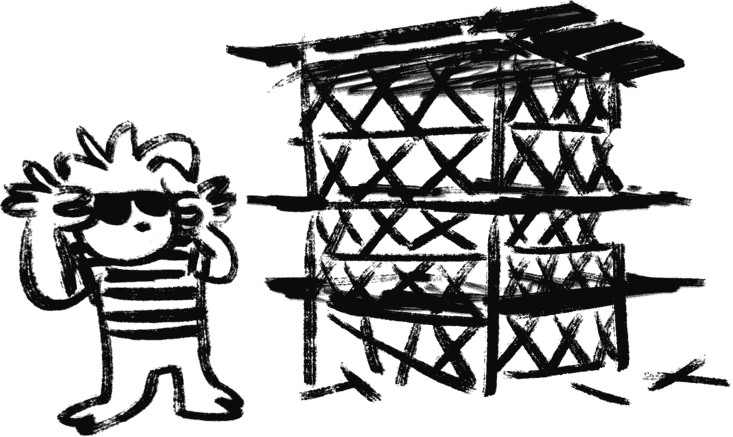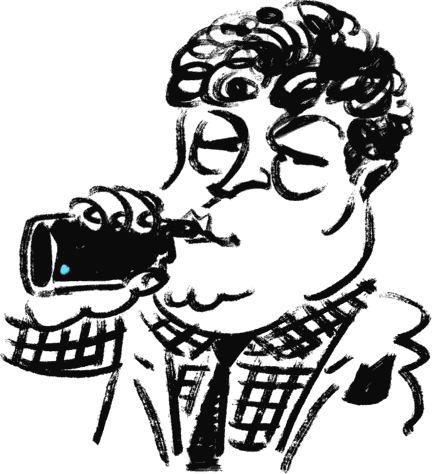Dip into the daily rituals of renowned artists and you’ll uncover a pattern that’s hard to miss: making great work requires we spend long stretches of time alone, everyday, struggling with our works-in-progress.¹
Social media creates the exact opposite of these conditions, leading us down the path to mediocre work.
Instead of long, uninterrupted time to work, our time is diced into notification checks – instead of a solid hour, we have “fifteen minutes, ten minutes, twenty-five minutes, five minutes and five minutes”². Instead of working alone, we’re always pseudo-connected to celebrities, puppies and the (way) better work of other artists. We don’t allow our work to fully develop and separate from us – we rush to the platforms with our embryonic sketches and look for attention.

The speed of social media feeds has us putting in brief efforts in exchange for approval. This trains us to know what ten minutes of our effort looks like, but undermines our patience to find out what we could do with ten months or years of sustained work. We’re lured into falling in love with scaffolding, and fail to build our church.
I asked, dear reader, about your social media use in connection with freelancing (readers here are mainly illustrators, designers, painters and animators) and reply after reply the pattern was: “I got some industry connections and a few small gigs, but now my relationship to social media is much more complicated.”
This complication has to do with the low value of returns we get for the hours poured into these sharing platforms. Almost seventy percent of Instagram followers have less than a thousand followers, and over ninety-two percent have less than fifty thousand.³ Ego, a student in my course was the only one to report a mostly positive impact of social media use, citing he has been “working as a full time freelancer using social media” without using “agent[s] or representation” (go, Ego!). He has close to seventy thousand followers on Instagram and even so, wants to expand beyond the platform.
Given these dismal statistics, folks in the US spend almost two hours every day on social media sites.⁴ Why do we use them so much if we gain so little? Why do artists feel they need to be on these platforms? Most of us share Kat’s sentiment: “I have always felt this pressure of being constantly active on [social media] but it has never gained me any results, just likes. I have never received any work from it and I can put a lot of time into it. I am always left thinking what is the point of it, or what am I doing wrong?”
FOMO.
We’re addicted to social media because it imparts some benefits. And something is harder to give up than nothing. Responses to my question all suggest the lure of this sometimes-benefit: Austin said, “I certainly attribute my early success as a freelancer to my activity and network created through social media”, echoing Johan, who told me “I’ve had some exposure and made connections with people overseas which has led to […] my most proudest work… which in the long term has helped build my reputation.”
The fact I gained something, no matter how much time and effort I put in, justifies my continued use. Rory Sutherland, vice chairman of Ogilvy observed, “one characteristic of humans is that we naturally direct our attention to the upside of any situation if an alternative narrative is available, minimising the downside.”⁵

This was true for my readers as well – every sometimes benefit relayed above was paired with a distinct unease about the slippery slope of using the platforms as validation for their work. Austin, who although found some initial success on social media, adds “I recognize that the majority of my social media usage is distraction,” similar to Johan’s observation – “I go through waves where I create something for social media, get that sugar rush and responses back that says I should keep going. But I question the value a week later, then I stop.”
As artists, our work is pushing the edges of our craft and feeling around in the dark for what is worthy to say. This takes a lot of trust in what it is we’re trying to do – a kind of trust that takes years to cultivate and is shaky at best. Casually swapping the slow effort needed to build that trust in the dark for the sometimes benefit of getting praise for throwing small sketches onto social media makes us, literally, followers rather than artists. Dave observed, “I think it is too easy to be a trend follower if you pay too much attention to what’s swirling around on all the sharing platforms.”
Instead of sitting there, a little anxious, thinking through what dimensions to make this next illustration, or sitting there, deleting chunks of work because the composition isn’t working, we’re increasingly allowing our processes and habits to be set by the platforms we’re on. Think about #everydays, where the aim is to create small, bite-sized pieces we can post on social media and get some fast love. Instead of deciding for ourselves the scope of our work, the length of our paragraphs and when and if our work is finished, we dash off small, quick pieces of content to platforms that loom fat with our attention. Johan describes this as “chasing the attention” while “[losing] sight of the work.”
Focusing on Making Great Work.
When we snap a picture of our work in progress and put it on social media, we stop the development of the piece. We freeze the artwork in time and signal to others and to ourselves that the piece is good enough for their eyes.
This makes for mediocre standards.
Great work comes from the struggle – “what’s essential,” pianist and polymath Stephen Hough points out, “is to focus on why something is not good.”⁶ (Emphasis mine.) It is finding and digging in to why our composition feels like a dead fish that allow us to scrap it and start again. It’s feeling through that exasperation which improves the work, not covering it up with anonymous, digital praise.
It’s wondering why our colors look so drab compared with artists we admire that give us the curiosity to improve. Twisting and writhing in that kind of struggle and anxiety is what elevates our work: alternately honing in on a patch of color or the smoothness of an animated path and then getting fed up with our tentative, boring, too-controlled efforts so much so that we give up – we let go, dare closer to the edge – and fly.
It’s in negotiating with ourselves to sit for an hour, ninety minutes, two hours and putting away all distractions that we can experience all the ways we want to run away from what is difficult about our work. Giving in to distraction, giving in to our temptations to think our work is already good enough for the eyes of others, robs us of creating work that has us in awe.
Walking that pattern (long stretches of time alone, everyday, struggling with works-in-progress) is hard and requires a faith that the work which comes about from that kind of a life is worth the price. We should want to know – need to know – what our sustained, difficult effort looks like because it is only the fruits of those efforts that justify the high price.
Guard your time.
Figure out if the ways you are dicing up your day is setting up the right conditions to produce the kind of work you actually want to make. Ultimately, Dave concludes in his email, “it comes down to time – I’m more interested in working on my craft skills [than my] social media skills.”
A piece of paper was found in Michelangelo’s studio after he died, addressed to his apprentice. On it he wrote:
“draw, Antonio, draw Antonio, draw and do not waste time.”⁷
*
A huge thank you to all the readers who took time out of their busy freelance lives to tell me their experiences with social media. I hope you find this piece relatable.
Thanks Sophie, for reading my many drafts!
- Currey, M. (2013). Daily Rituals: How Artists Work. Knopf.
- Fried, Jason. (2016). “What’s an hour?” Signal vs. Noise blog.
- Mention. (2018). Instagram Engagement Report 2018.
- Statista. (2019). “Daily time spent on social networking by internet users worldwide from 2012 to 2018”.
- Sutherland, R. (2019). Alchemy: The Dark Art and Curious Science of Creating Magic in Brands, Business, and Life. William Morrow. pp. 321.
- Hough, S. (2020). Rough Notes. Farrar, Straus and Giroux. pp. 136.
- Dillard, A. (2013). The Writing Life. Harper Perennial. pp. 79.
